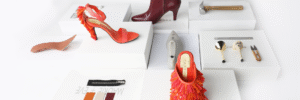Starting your own shoe brand isn’t just about making great shoes — it’s about building a lasting identity that connects with people. Every successful brand, from Nike’s bold innovation to emerging European shoe labels known for craftsmanship, began with a clear strategy and a strong sense of purpose. A well-defined brand vision helps you decide who your customers are, how your designs stand out, and which shoe manufacturer best supports your goals. Whether you dream of launching a minimalist sneaker line or a premium footwear collection, this guide will walk you through every step — from naming your brand to production and marketing — to help you make your own shoe brand the right way.
How to Make a Shoe Brand from Scratch
To make your own shoe brand, you must first understand the global footwear market. The industry is highly competitive — from sports shoes and fashion heels to high-end custom footwear — and new brands can only stand out by identifying a unique niche and audience. Whether it’s eco-friendly materials, functional design, or urban commuter styles, defining your positioning is the key to survival.
When learning how to make a shoe brand, many beginners confuse “selling shoes” with “building a brand.” Selling shoes is a transaction, while building a brand means creating an identity, story, and consistent value that consumers can connect with. A true shoe brand communicates craftsmanship, lifestyle, and trust beyond the product itself.
Choosing the right shoe manufacturer is the foundation of success. A reliable factory ensures accurate samples, stable production, and on-time delivery. On the other hand, poor supply chain choices can lead to disastrous results — for example, one startup brand missed its launch season because its factory delayed production and delivered poor-quality shoes, causing wasted marketing investment and damaged reputation. Working with an experienced private label shoes manufacturer can significantly reduce these risks and ensure smooth progress from design to production.
In short, building a shoe brand starts not with design, but with understanding the market, setting a clear strategy, and partnering with a trusted manufacturer to secure a strong foundation for long-term growth.
Finding Your Brand Identity: From Vision to Style
In the process of creating a shoe brand, defining your brand identity is the core of your success. Start by clarifying your mission, design philosophy, and target audience. What does your brand stand for — modern comfort, timeless elegance, or sustainable craftsmanship? Understanding your customers’ lifestyles, age, and values will help you shape your aesthetic direction and communication tone.
The branding of shoes goes beyond just a logo or color palette — it’s about building emotional resonance. Your color scheme, tone, and personality must stay consistent to create strong recognition. For example, black and gold convey sophistication and confidence, while beige and tan express natural warmth and handcrafted quality. From your website design and packaging to marketing materials, every element should echo your brand’s unique identity.
For inspiration, look at premium footwear brands such as Cole Haan or Tod’s, which seamlessly blend luxury with everyday comfort and ethical craftsmanship. Their designs emphasize high-quality materials, attention to detail, and timeless appeal — showing how a brand can be both aspirational and approachable.
Ultimately, a successful shoe brand transforms its vision into style, turning each pair of shoes into a reflection of its values, aesthetics, and personality.
Naming Your Business: Creative Shoe Brand Name Ideas
A great brand name is the first step toward building emotional connection and lasting recognition. To create unique shoe business name ideas, start by ensuring your name aligns with your brand identity. For a premium or light luxury footwear brand, the name should carry a sense of classical elegance — often inspired by Latin or French roots — evoking artistry and timeless charm. In contrast, modern or concept-driven brands should choose bold, expressive names that highlight innovation and individuality.
For example, Tod’s is short, powerful, and globally recognizable, reflecting understated Italian luxury. Allbirds draws from nature, symbolizing sustainability and lightness in design. Maison Margiela combines avant-garde creativity with artistic sophistication, embodying the spirit of a designer brand. These brand name ideas for shoes succeed because they are simple, memorable, and deeply aligned with their core values.
Once you’ve chosen a potential name, check domain and trademark availability. A short, easy-to-remember domain strengthens online branding and SEO performance. At the same time, trademark registration ensures legal protection and prevents future disputes. Ultimately, a distinctive and secure brand name sets the foundation for long-term growth and market credibility.
Designing and Producing Your First Shoe Collection
When you’re ready to bring your shoe concept to life, working with an experienced shoe manufacturer is the key first step. The process begins with turning your sketches into prototypes, and two essential services to look for are shoe last creation and shoe prototyping. A well-designed shoe last not only defines the proportions and silhouette of your design but also determines comfort and fit. Most professional manufacturers provide full support — from last development to prototype production — helping brands move smoothly from concept to market.
Material selection is equally important. Natural leather offers superior breathability, softness, and the ability to develop a unique patina over time, while synthetic leather provides better durability, affordability, and aligns with vegan or sustainable fashion goals.
For brands aiming at the premium segment, consider creating a European shoe special line — for example, by adopting Italian lasts or incorporating European hand-stitching craftsmanship. This approach enhances your brand’s luxury appeal and attracts consumers who value quality and artisanal details.
By combining precise prototyping, thoughtful material selection, and collaboration with skilled manufacturers, your first shoe collection can achieve both aesthetic excellence and strong market potential.
Building a Strong Brand Image and Market Presence
In the world of luxury footwear, brand image determines whether a brand can truly stand out. A great product is only the foundation — what resonates most with consumers is the story, visual identity, and values behind it. Many successful European brands, such as Santoni, Berluti, and Tod’s, have built a reputation for timeless elegance by combining refined craftsmanship with authentic storytelling.
Photography and storytelling play a crucial role in communicating brand identity. High-quality images don’t just showcase the texture and silhouette of shoes — they express a lifestyle. For example, brands like Jimmy Choo and Aeyde use minimalist, emotionally driven visuals that make viewers instantly connect with their aesthetic and philosophy.
Packaging is another essential element of branding. A premium shoe brand pays attention to every detail — from the shoe box design and embossed logo to the silk dust bag — turning every unboxing experience into a moment of luxury.
In the digital era, collaborations with fashion influencers and participation in runway shows or trade fairs are powerful ways to boost visibility. Presenting your prototype collection on such stages not only highlights your craftsmanship but also strengthens global credibility and brand recognition.
Ultimately, a successful footwear brand combines technical mastery with emotional storytelling — allowing every pair of shoes to reflect a unique sense of beauty, identity, and culture.
Launching and Selling Your Shoe Brand
In today’s fashion landscape, launching your own shoe brand successfully depends on choosing the right strategy for visibility, pricing, and customer connection. With the rise of digital retail, more and more luxury and contemporary footwear brands are choosing eCommerce as their primary sales channel. Platforms like Instagram and Pinterest are used to build brand identity and share design stories, while Shopify or Wix enable global online sales. This direct-to-consumer model not only lowers entry barriers but also helps brands build emotional relationships with their audience.
When it comes to pricing and production management, a modern luxury brand should focus on storytelling rather than price. Unlike traditional luxury, the strength of a premium or “affordable luxury” shoe line lies in its philosophy, craftsmanship, and originality. Managing production runs wisely helps maintain both exclusivity and cash flow balance — limited quantities often create stronger perceived value.
Building customer loyalty is the next critical step. Offering personalized after-sales services, repair programs, or exclusive limited editions can strengthen your customer relationships and brand community.
If you’re learning how to make your own shoe brand, remember this: the product is only the beginning — what truly defines success is your brand vision, story, and the experience you create for every customer.
Scaling Up: From Startup to Premium Footwear Brand
Once your shoe brand has completed its initial prototypes and gained early market validation, the next step is to think strategically about scaling up — transforming your startup into a true premium footwear brand. This stage focuses on expanding collections, improving craftsmanship, and gradually building an international presence.
Start by broadening your product range and refining production quality. Evolve from a single style into a cohesive collection — including heels, boots, loafers, and sneakers — while maintaining a consistent brand identity. Invest in higher-grade materials like vegetable-tanned leather, hand-stitched detailing, and sustainable production processes that enhance both the tactile and visual quality of your shoes. This craftsmanship-first approach will naturally elevate your brand’s reputation.
Next, consider partnering with international distributors or local boutiques. For example, you can collaborate with nearby independent stores or fashion retailers to introduce limited editions or exclusive collections. Such partnerships help increase visibility, strengthen credibility, and expand your customer base beyond online channels.
Finally, to evolve into one of the premium footwear brands recognized for craftsmanship and ethics, your brand must strike a balance between style, quality, and sustainability. A successful shoe brand doesn’t just produce beautiful footwear — it represents integrity, creativity, and responsibility. By staying true to your design philosophy and sustainability goals, you can build a global brand that stands for both elegance and purpose.




